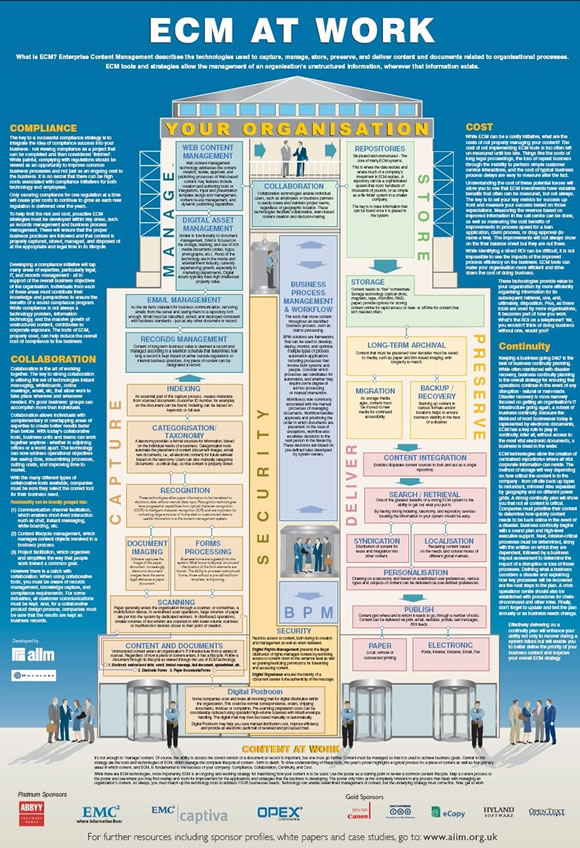
Content management is changing fast in a more customer- and business-oriented context. An overview of the trends in content management, Big Data and information management with John Mancini, leader of the AIIM global community of information professionals.
Last year AIIM published a paper with Kodak Alaris Information Management (one of our partners) on Intelligent Information Management and how it helps improving the customer experience. In the introduction, AIIM emphasizes the importance of accomodating the mutitude of channels and content types customers use for communications from a content input and analysis context.
Information and content management – in the broadest sense – is at the service of the customer – also in the broadest sense – and his experience(s) indeed. When asked, Mancini defines intelligent information management as the combination of analytics, collaboration, organizational processes and mobility to create systems that better engage customers, employees, and partners. And it’s clear digital plays an increasing role in it…
Information, technology, the business and the customer
Digital has become so pervasive across the enterprise and its’ ecosystem that we need to connect the silos we created and there is a stronger call for a better collaboration between IT and the business and today especially the CIO and the CMO. How is the traditionally still more IT-oriented world of Enterprise Content Management (ECM) evolving in this context of evolving changing business and customer demands and new technologies.
John Mancini: Driven both by the mainstreaming of content technologies and the entry of consumer technologies (consumerization, BYOD,…) into the enterprise, there has been a dramatic evolution in who buys content management and how they approach the content management buy decision.
In the recent past, much of the following was/is true…
- The focus of IT was on cost reduction.
- Senior executives were largely technology oblivious (one CEO recently told me, “I viewed IT as a big hairball I just hoped would go away.”)
- Job security was found in system complexity.
- As mobile and social entered the world of systems of record, initially just their sheer existence was a source of competitive differentiation.
- System implementations were long and paid for by capital expenditures (CAPEX).
- Technical skills in and of themselves had value.
There has been a dramatic evolution in who buys content management and how they approach the content management buy decision.
Content management is changing: here is how
Businesses start putting the customers and their experiences first and dropping the channel first mentality. The content management industry starts using new terms and talks about experience management, customer engagement, etc. instead of content management. It’s all about the connected customer experience. Where do you see the major underlying shifts happening in these efforts on a product level. How are ECM solutions changing?
John Mancini: content management is certainly changing and the “ECM” term is feeling strained:
- The lines blur between structured and unstructured information.
- Processes begin to replace content at the core.
- The convergence of Social, Mobile and the Cloud are creating a “content” value proposition in consumer markets.
- It is increasingly difficult to determine where “industry” ends and where it begins.
Content management has always been viewed through the prism of technologies — what it IS. I think increasingly content management will be viewed through the prism of what it DOES.
The convergence of Social, Mobile and the Cloud are creating a “content” value proposition in consumer markets.
What are the main challenges for the ECM and collaboration industry today? Recently I saw you speaking about intelligent information management and the customer experience. Is this where the major challenges are? The famous maybe somewhat black and white migration from systems of record to systems of engagement? More focus on the customer experience?
John Mancini: Forrester talks about how the combination of cloud, SaaS, mobile, social, and analytics dramatically changes the nature of collaboration, making it possible for the first time to truly address all of the grey areas of our business processes. They call this opportunity “Smart Process Applications,” and I think there is a great deal to this line of thought. Every industry has processes that at first glance seem automated. And at the surface level they are. But the reality beneath the surface is that most processes have countless branches and outcroppings where right now lots of manual and ad hoc collaboration occurs. It is in the automation of these “exceptions” that enormous opportunity lies.
Increasingly content management will be viewed through the prism of what it DOES.
Making business sense of big data: where content comes in
Big data, big content, fast data, you name it. Even if big data is probably hyped a bit, it’s clear that we’re living in a world of data, connected with information, people and business goals. What is the major impact and role of big data according to you?
John Mancini: As businesses try to make sense of big data, I’m reminded of how contradictory forces – like the yin and yang principle of Chinese philosophy – can bring balance to a situation in order to move it forward. In my opinion, there is an over-emphasis on big data technology and a need for a balancing focused on the business side of the big data equation. Lots of new data scientists will be needed in the years ahead to interpret all of the data we are generating today.
However, we also need a new set of talents and strategies that allow us to act upon these insights. To exploit big data, the interdependency between technology and business must be addressed so business managers can minimize risk to focus on the benefits. And at the center of how we will ACT upon the INSIGHTS gathered by big data will be content. And lots of it.
There is an over-emphasis on big data technology and a need for a balancing focused on the business side of the big data equation.
Changes organizations need to align with
You know the industry inside-out and understand where the dots are getting connected. What major evolutions and trends do you see in the market the coming years? What should an organization start doing right now from the content and information perspective to be ready for those evolutions?
John Mancini: In the new world we are moving into, much of the following is/will be true and organizations need to align their strategies with these changes:
- The central mission of IT is morphing toward value creation.
- Senior executives are much more technology aware than they once were.
- The coin of the realm is now simplicity rather than complexity.
- We have quickly moved into an environment in which mobile and social are becoming table stakes rather than differentiators in an enterprise IT strategy.
- The desired purchase mode is by the drink rather than by the gallon — in other words, operating expenditures instead of capital expenditures.
It’s clear: the focus is shifting from the many ‘management’ dimensions in ECM (document management, records management, digital rights management, digital asset management, web content management, etc.) to the ‘outcome’ dimensions with more integration and a focus on the solutions first. Of course, this doesn’t mean that the management part is not important, well on the contrary. It’s just not only about the technology perspective. It’s about much more than it was. ECM at work gets a new meaning.


